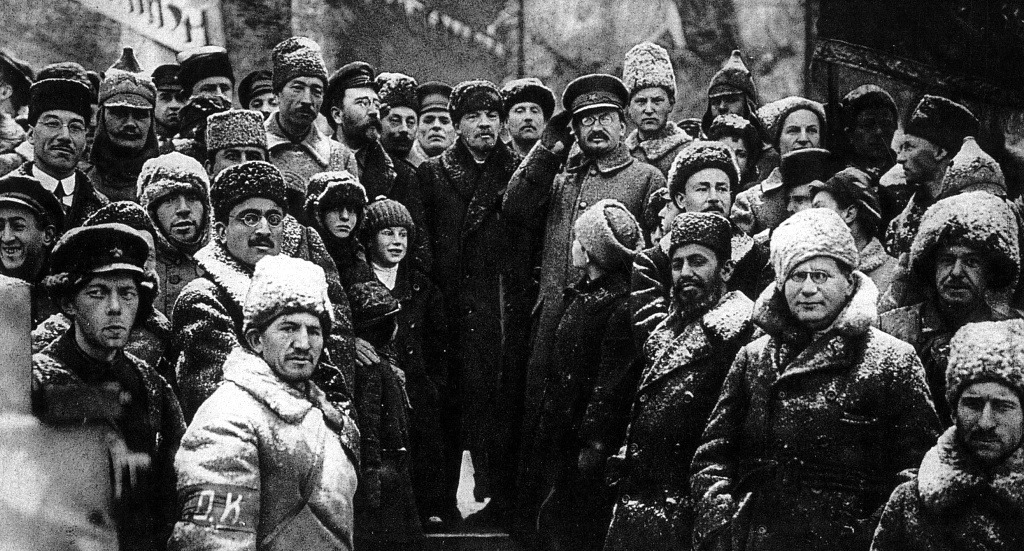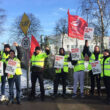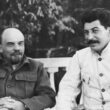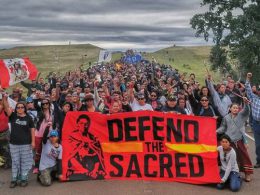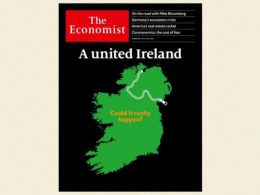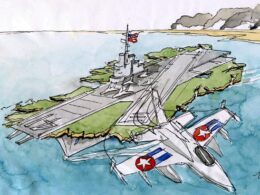The Russian revolutionary leader Vladimir Ilyich Ulyanov, better known as Lenin, died on 21 January 1924 — 100 years ago. The party he led, known as the Bolsheviks and later the Communist Party, took power in the October Revolution of 1917, the first successful working-class and socialist revolution in history.
Lenin by Trotsky
LENIN, VLADIMIR ILYICH ULYANOV (1870–1924), founder and guiding spirit of the Soviet Republics and the Communist International, the disciple of Marx, the leader of the Bolshevik party and the organizer of the Oct. revolution in Russia, was born on April 9 (22), 1870, in the town of Simbirsk, now Ulyanovsk. His father, Ilya Nicolaevitch, was a schoolmaster. His mother, Maria Alexandrovna, was the daughter of a doctor named Berg. His eldest brother (b. 1866) joined the “Narodovoltze” (a revolutionary terrorist society), and taking part in the unsuccessful attempt on the life of Alexander III., was executed (1891); this was a determining factor in Lenin’s life.
Early life
The third of a family of six, Lenin completed his course at the Simbirsk gymnasium in 1887, winning the gold medal. He entered the Kazan University to study law, but was sent down in Dec. of the same year for taking part in a gathering of students and was banished to the country. It was not till the autumn of 1889 that he was allowed to return to Kazan, where he began the systematic study of Marx and met the members of the local Marxist circle. In 1891 Lenin passed the law examinations of the St. Petersburg University, and in 1892 he began to practise as a barrister at Samara, appearing for the defence in several trials. His life, however, was chiefly filled by the study of Marxism and its application to the economic and political development of Russia and subsequently of the whole world.
In 1894 he moved to St. Petersburg, and began his propaganda work. To this period belong Lenin’s first polemical writings directed against the popular party and passed from hand to hand in manuscript form. Soon after, Lenin started in the Press a theoretical struggle against the falsifiers of Marx.
In April 1895 he first went abroad to meet Plekhanov, Zasulich, Axelrod and the Marxist group known as the “Osvobozhdenie Truda” (Deliverance of Labour). On his return to St. Petersburg, he organized the illegal “Union for the Liberation of the Working Class,” which rapidly became an important organization, carrying on propaganda among the workers.
In Dec. 1895 Lenin and his closest collaborators were arrested. He spent the year 1896 in prison, and in Feb. 1897 he was exiled for three years to the Yenisei province in eastern Siberia. In 1898 he married N.K. Krupskaya, a comrade in the St. Petersburg Union and his faithful companion for the remaining 26 years of his life. During his exile he finished his most important economic work, The Development of Capitalism in Russia, based on an enormous mass of statistical material (1899).
In 1900 Lenin went to Switzerland to arrange, with the “Deliverance of Labour” group, the publication of a revolutionary paper intended for Russia. At the end of the year the first number of the paper Iskra (The Spark) appeared in Munich, with the motto “From Spark to Flame.” Its aim was to give a Marxian interpretation of the problems of the revolution, with the political watchwords of the struggle, and to form a centralized “underground” revolutionary party of Social Democrats, which, standing at the head of the proletariat, should open the struggle against Tsarism.
The idea of an organized party leadership of the struggle of the proletariat in all its forms and manifestations, which is one of the central ideas of Leninism, is closely connected with the idea of the hegemony of the working class within the democratic movement of the country. This idea found direct expression in the programme of the dictatorship of the proletariat when the development of the revolutionary movement had prepared the conditions for the Oct. revolution.
Bolsheviks and Mensheviks
The second Congress of the R.S.D.R.P. (Brussels, London) in July and Aug. 1903 accepted the programme worked out by Plekhanov and Lenin, but ended with the historic split of the party into Bolsheviks and Mensheviks. Thereupon Lenin entered on his separate path as leader of the Bolshevik section, later the Bolshevik party.
The differences concerned tactics and finally the party programme. The Mensheviks tried to bring the policy of the Russian proletariat into line with that of the liberal bourgeoisie. Lenin saw in the peasantry the closest ally of the proletariat. Occasional agreements and closer relations with the Mensheviks failed to arrest the constant widening of the two lines — the revolutionary and the opportunist — the proletarian and the bourgeois. The struggle with the Mensheviks forged the policy which led to the break with the Second International (1914), to the Oct. revolution (1917) and to the change of the party’s name from Social Democrat to Communist (1918).
A revolutionary situation was created in the country by the defeat of the army and navy in the Russo-Japanese War, the shooting of the workers on Jan. 9 (22) in 1905, by agrarian disturbances and political strikes. Lenin’s programme was the preparation of an armed rising of the masses against Tsarism, and the creation of a provisional Government to organize the revolutionary democratic dictatorship of the workmen and peasants for the deliverance of the country from Tsarism and serfdom.
The third congress of the party, consisting exclusively of Bolsheviks (May 1905), passed a new agrarian programme which included the confiscation of the domains of landowners. In Oct. 1905 the All-Russian strike began. On the 17th of the month the Tsar issued his manifesto about the “Constitution.” In the beginning of Nov. Lenin returned to Russia from Geneva, and appealed to the Bolsheviks to bring into the party wider circles of workers, but to retain their illegal apparatus in anticipation of counter-revolutionary blows.
In the events of 1905 Lenin distinguished three main features — (1) the temporary seizure by the people of real political freedom, (2) the creation of new if only potential revolutionary power in the shape of soviets of workers’, soldiers’ and peasants’ deputies; (3) the use of force by the people against those who had employed it against them. Those conclusions, from the events of 1905, became the guiding principles of Lenin’s policy in 1917 and led to the dictatorship of the proletariat in the form of the Soviet State.
The rising in Moscow at the end of Dec., lacking as it did the support of the army, without simultaneous risings in other towns and sufficient response in the country districts, was quickly suppressed. The Liberal bourgeoisie came to the front. The epoch of the first two Dumas began. At this time, Lenin formulated the principles of the revolutionary exploitation of parliamentary methods as a means of fresh attack.
In Dec. 1907 Lenin left Russia, to return only in 1917. Now (in 1907) began the epoch of victorious counter-revolution, prosecutions, exile, executions and emigration. Lenin led the struggle against the Mensheviks, the advocates of the liquidation of the “underground” party — hence those known as “liquidators” — and of the change of their methods into legal ones within the framework of the existing regime; against the “conciliators” who tried to take up an intermediate position between Bolshevism and Menshevism — against the Socialist Revolutionaries who tried to make up for the inertia of the masses by personal terrorism; finally, against those Bolsheviks, the so-called “callers-off,” who demanded the recall of the Social Democratic deputies from the Duma in the name of immediate revolutionary activity.
At the same time, Lenin carried on an extensive campaign against the attempt to revise the theoretic basis of Marxism on which his whole policy was founded. In 1908 he wrote a major treatise directed against the essentially idealistic philosophy of Mach, Avenarius and their Russian followers, who tried to unite empiric criticism with Marxism. Lenin proved that the methods of dialectical materialism as formulated by Marx and Engels were confirmed by the development of scientific thought in general and natural science in particular. Thus Lenin’s constant revolutionary struggle went hand in hand with his theoretical controversies.
The years 1912–14 were marked in Russia by a fresh outburst of activity in the workers’ movement. Breaches made their appearance in the counter-revolutionary regime. At the beginning of 1912 Lenin summoned a secret conference of the Russian Bolshevik organizations in Prague. The “liquidators” were declared to be outside the party. The split with the Mensheviks became final.
A new central committee was elected. Lenin organized from abroad the publication in St. Petersburg of a legal newspaper, Pravda, which in its constant conflict with the censorship and the police exercised a guiding influence on the vanguard of the working class. In July 1912 Lenin, together with his closed colleagues, moved from Paris to Krakow in order to be in closer touch. The revolutionary movement in Russia was growing, and was thereby giving the Bolsheviks the preponderance. Lenin sent articles under different pseudonyms almost every day to the Bolshevik legal newspapers, drawing the inevitable inferences from them in the illegal (“underground”) Press.
At this time, as well as before and after it, N.K. Krupskaya was the centre of the organizing work. She received comrades from Russia, gave instructions to others on their way there, set up “underground” connections, wrote, coded and decoded letters. It was in the small town of Poronin in Galicia that the declaration of war found Lenin. The Austrian police suspected him of being a Russian spy and arrested him; he was, after a fortnight, expelled to Switzerland.
Internationalism. — A new and international phase of Lenin’s work now opened. His manifesto, published in the name of the party on Nov. 1, 1914, denounced the imperialistic character of the War and the war guilt of all the great powers, who had long been preparing a sanguinary struggle for the purpose of widening their markets and destroying their rivals. The patriotic agitation of the bourgeoisie on both sides, who threw the blame each upon the other, was shown to be a maneuver to deceive the workers.
The manifesto points out that the majority of Social Democratic leaders were on the side of the bourgeoisie of their own country, thus violating the resolutions of the International Socialist congresses and bringing about the downfall of the Second International. The defeat of their “own” governments should be the slogan of the Social Democrats of all countries. Lenin subjects to a merciless criticism not only Socialist patriotism, but that pacifism which, while occupied with platonic protests, withdraws from the revolutionary struggle with imperialism. The struggle with pacifism develops into a great struggle with those elements of the working class movement which are midway between the Social Democrats and the Communists, supporting the former in actual practice.
The theorists and politicians of the Second International redoubled the accusations of anarchism which they had before brought against Lenin. As a matter of fact, all Lenin’s work was characterized by a twofold struggle, on the one hand with reformism which from the beginning of the War gave its support to the imperialist policy of the propertied classes, and on the other hand with anarchism and all the different varieties of revolutionary adventurists.
On Nov. 1, 1914 Lenin promulgated a programme for the creation of a new International “to undertake the task of organizing the forces of the proletariat for the revolutionary attack on capitalist governments, for the civil war against the bourgeoisie of all countries, for the attainment of political power and the victory of Socialism.”
In Sept. 1915 (Sept. 5 and 8) there was held at Zimmerwald in Switzerland the first conference of European Socialists who were opposed to the imperialistic war. Thirty-one delegates were present. The left wing of the Zimmerwald conference and of the later one at Kiental adopted Lenin’s demand for the transformation of the imperialist war into a civil war, and became the nucleus of the future Communist International. The latter worked out its programme, tactics and organization under Lenin’s guidance, and it was he who directly inspired the decisions of the first four congresses of the Communist International.
Lenin was prepared for his struggle on an international scale not only by his profound knowledge of Marxism and his experience of the revolutionary party organization in Russia, but also by his intimate acquaintance with the workers’ movement throughout the world. He was master of the English, German and French languages, and could read Italian, Swedish and Polish. He was firmly opposed to the mechanical application of the methods of one country to another, and he investigated and decided questions concerning revolutionary movements, not only in their international reactions, but also in their concrete national form.
Revolution of 1917. — The revolution of Feb. 1917 found Lenin in Switzerland. His attempts to reach Russia met with the opposition of the British Government, and he decided to travel through Germany. The success of this plan gave occasion to Lenin’s enemies for a fierce campaign of slander, which, however, was powerless to prevent him from assuming the leadership of his party and shortly afterwards of the revolution.
On the night of April 4, on leaving the train, Lenin made a speech in the Finlyandsky station in Petrograd. He repeated and developed the leading ideas it contained in the days which followed. The overthrow of Tsarism, he said, was only the first stage in the revolution. The bourgeois revolution could no longer satisfy the masses. The task of the proletariat was to arm, to strengthen the power of the Soviets, to rouse the country districts and to prepare for the conquest of supreme power in the name of the reconstruction of society on a Socialist basis.
This far-reaching programme was not only unwelcome to those engaged in propagating patriotic Socialism, but even roused opposition among the Bolsheviks themselves. Plekhanov called Lenin’s programme “crazy.” Lenin, however, foresaw that the distrust of the bourgeoisie and of the Provisional Government would grow stronger daily, that the Bolshevik party would obtain a majority in the Soviets and that the supreme power would pass into their hands. The small daily Pravda became at once in his hands a powerful instrument for the overthrow of bourgeois society.
The policy of coalition with the bourgeoisie pursued by the patriotic Socialists, and the hopeless attack which the Allies forced the Russian Army to assume at the front roused the masses and led to armed demonstrations in Petrograd in the first days of July. The struggle against Bolshevism became intense. On July 5th forged “documents” were published by the counter-revolutionary secret service, purporting to prove that Lenin was acting under the orders of the German general staff. In the evening “reliable” detachments summoned from the front by Kerensky and Cadet officers from the districts around Petrograd occupied the city. The popular movement was crushed. The hounding of Lenin reached its height. He now began to work “underground,” hiding first in Petrograd with a worker’s family and then in Finland.
The July days and the retributions which followed aroused a burst of energy in the masses. The Bolsheviks obtained a majority in the Soviets of Petrograd and Moscow. Lenin demanded decisive action to seize the supreme power. “Now or never!” he repeated in passionate articles, letters and interviews.
The Soviet of People’s Commissaries. — The rising against the Provisional Government coincided with the opening of the second Congress of the Soviets on Oct. 25. Lenin, after being in hiding for three and a half months, appeared in the Smolny Institute and directed the fight. In the night sitting of Oct. 27 he proposed a draft decree about peace which was passed unanimously and another about the land, which was passed with one dissentient and eight abstentions. The Bolshevik majority, supported by the left wing of the Socialist Revolutionaries, declared that supreme power was now vested in the Soviets. The Soviet of People’s Commissaries was appointed, with Lenin at the head.
Having obtained the land of the estate owners, the peasants supported the Bolsheviks. The Soviets became masters of the situation. The constituent assembly which was elected in Nov. and met on Jan. 5 was an anachronism. The conflict between the two stages of the revolution was at hand. Lenin did not hesitate for an instant. On the night of Jan. 7 the All-Russian Central Executive Committee, on Lenin’s motion, passed a decree dissolving the constituent assembly. The dictatorship of the proletariat, said Lenin, meant the greatest possible degree of democracy for the toiling majority of the people, putting in the hands of labour all those material goods (buildings for meetings, printing presses and so on) lacking which “liberty” remains an illusion. The dictatorship of the proletariat in Lenin’s view is a necessary stage in the abolition of class divisions in society.
The question of war and peace provoked a new crisis. A considerable proportion of the party demanded a “revolutionary war” against the Hohenzollerns, leaving out of account altogether the economic situation of Russia and the temper of the peasantry. Lenin felt that it was necessary for propaganda purposes to drag out negotiations with the Germans for as long as possible. But he demanded that, in the event of a German ultimatum, peace should be signed even at the price of a loss of territory or the payment of an indemnity. The revolution kindling in the west would sooner or later undo the hard terms of peace.
Lenin’s political realism manifested itself in all its strength in regard to this question. The majority of the Central Committee in opposition to Lenin made a further attempt to avoid yielding to German imperialism by declaring the state of war at an end, but refusing at the same time to sign an imperialistic peace. This led to a renewed attack by the Germans. After heated debates in the Central Committee at the sitting of Feb. 18 Lenin won a majority for his proposal that negotiations should be reopened forthwith, and that the German terms which were now still more unfavourable should be signed.
The Soviet Government on Lenin’s initiative transferred itself to Moscow. Peace having been attained, Lenin now brought before the party and the country the whole question of its economic and cultural organization.
The greatest trials, however, were still to come. By the end of the summer of 1918 Central Russia found itself surrounded by a ring of fire. Hand in hand with the Russian counter-revolution there came the rising of the Czechoslovaks on the Volga; on the north and south came the British intervention (in Archangel on Aug. 2, in Baku on Aug. 14). Food supplies were cut off. Lenin never ceased to direct his party and the Government. He carried on propaganda work, roused the masses, organized the getting of corn; followed the enemy’s movements, was in direct communication with the Red Army. He followed the international situation, finding his bearings by the dissensions in the camps of the imperialists. He found time for interviews with foreign revolutionaries and with Soviet engineers and economists.
On Aug. 30 the Social-Revolutionary Kaplan aimed two shots at Lenin when on his way to a workers’ meeting. This attack intensified the civil war. Lenin’s strong constitution quickly recovered from the effect of his wounds. During his convalescence he wrote a pamphlet, The Proletarian Revolution and the Renegade Kautsky, directed against the most prominent theorist of the Second International. By Oct. 22 he was again speaking in public.
The New Economic Policy
The war on the home fronts remained his chief occupation. Economic and administrative problems had necessarily to take a subordinate place. The civil war fed from abroad was at its height. The struggle ended at the beginning of 1921 with the utter defeat of the counter-revolution and the Government grew in strength. The fact that the War had not led immediately to a proletarian revolution in Europe had enormously increased the difficulties of Socialist reconstruction, which was impossible without agreement between the proletariat and the peasantry. The system of requisitioning superfluities from the peasants must be replaced by a tax correctly assessed. Private interchange of commodities must be allowed. These measures began a new phase in the development of the Oct. (Nov.) revolution, that known as the “new economic policy.”
In his policy within the Soviet Federation Lenin tried, in every way to create for the nationalities which had been oppressed under Tsarism, conditions of free national development. He made unsparing war against all imperialist tendencies especially within the party itself — the purity of whose ideas he guarded with the utmost jealousy. The charges of oppressing nationalities made against Lenin and his party with reference to Georgia, etc., were the product of the sharp class warfare within the nation.
The principles of national self-determination, Lenin insisted on applying in full to colonial peoples. His doctrine was that the Western European proletariat should refrain from mere declarations of sympathy with oppressed nationalities, and instead should join them in the struggle against imperialism.
At the eighth congress of Soviets (1920) Lenin made a report on the work carried out on his initiative for the drafting of a plan for the electrification of the country. The gradual effort towards a high degree of technical development is the mark of the successful transformation from the system of small-scale peasant economy, with its lack of co-ordination, to the system of large-scale Socialist production based on a single, comprehensive plan. “Socialism is a Soviet Govt. plus electrification.”
Death
The exhaustion brought on by excessive hard work over a number of years ruined Lenin’s health. Sclerosis attacked his cerebral arteries. At the beginning of 1922 his doctors forbade him daily work. From June to Aug. the disease made rapid progress, and for the first time he began to lose the power of speech, and in Dec. he became paralysed in the right arm and leg. He died on Jan. 21, 1924, at 6.30 p.m., at Gorky, near Moscow. His funeral was the occasion for an unexampled manifestation of love and grief on the part of millions.
Lenin’s outward appearance was distinguished by simplicity and strength. He was below the middle height, with the plebeian features of the Slavonic type of face, brightened by piercing eyes; and his powerful forehead and still more powerful head gave him a marked distinction. He was tireless in work to an unparalleled degree. He put the same exemplary conscientiousness into reading lectures in a small workmen’s club in Zurich and in organizing the first Socialist State in the world. He appreciated and loved to the full science, art and culture, but he never forgot that as yet these things are the property of a small minority. His way of life in the Kremlin was little different from his life as an émigré abroad. The simplicity of his daily habits was due to the fact that intellectual work and intense struggle not only absorbed his interests and passions but also gave him intense satisfaction. His thoughts never ceased to labour at the task of freeing the workers.





